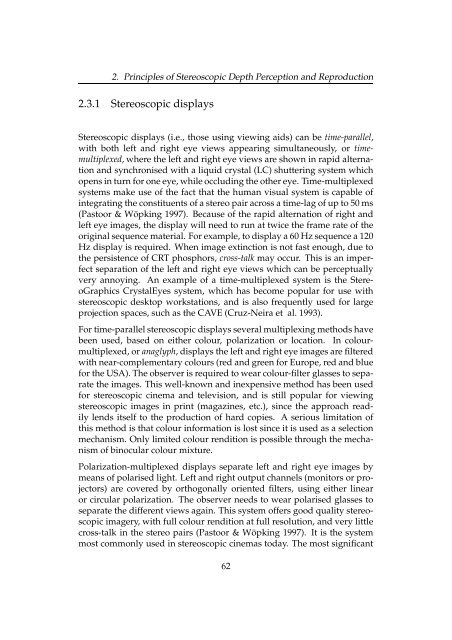Chapter 2 Principles of Stereoscopic Depth Perception and ...
Chapter 2 Principles of Stereoscopic Depth Perception and ...
Chapter 2 Principles of Stereoscopic Depth Perception and ...
Create successful ePaper yourself
Turn your PDF publications into a flip-book with our unique Google optimized e-Paper software.
2. <strong>Principles</strong> <strong>of</strong> <strong>Stereoscopic</strong> <strong>Depth</strong> <strong>Perception</strong> <strong>and</strong> Reproduction<br />
2.3.1 <strong>Stereoscopic</strong> displays<br />
<strong>Stereoscopic</strong> displays (i.e., those using viewing aids) can be time-parallel,<br />
with both left <strong>and</strong> right eye views appearing simultaneously, or timemultiplexed,<br />
where the left <strong>and</strong> right eye views are shown in rapid alternation<br />
<strong>and</strong> synchronised with a liquid crystal (LC) shuttering system which<br />
opens in turn for one eye, while occluding the other eye. Time-multiplexed<br />
systems make use <strong>of</strong> the fact that the human visual system is capable <strong>of</strong><br />
integrating the constituents <strong>of</strong> a stereo pair across a time-lag <strong>of</strong> up to 50 ms<br />
(Pastoor & Wöpking 1997). Because <strong>of</strong> the rapid alternation <strong>of</strong> right <strong>and</strong><br />
left eye images, the display will need to run at twice the frame rate <strong>of</strong> the<br />
original sequence material. For example, to display a 60 Hz sequence a 120<br />
Hz display is required. When image extinction is not fast enough, due to<br />
the persistence <strong>of</strong> CRT phosphors, cross-talk may occur. This is an imperfect<br />
separation <strong>of</strong> the left <strong>and</strong> right eye views which can be perceptually<br />
very annoying. An example <strong>of</strong> a time-multiplexed system is the StereoGraphics<br />
CrystalEyes system, which has become popular for use with<br />
stereoscopic desktop workstations, <strong>and</strong> is also frequently used for large<br />
projection spaces, such as the CAVE (Cruz-Neira et al. 1993).<br />
For time-parallel stereoscopic displays several multiplexing methods have<br />
been used, based on either colour, polarization or location. In colourmultiplexed,<br />
or anaglyph, displays the left <strong>and</strong> right eye images are filtered<br />
with near-complementary colours (red <strong>and</strong> green for Europe, red <strong>and</strong> blue<br />
for the USA). The observer is required to wear colour-filter glasses to separate<br />
the images. This well-known <strong>and</strong> inexpensive method has been used<br />
for stereoscopic cinema <strong>and</strong> television, <strong>and</strong> is still popular for viewing<br />
stereoscopic images in print (magazines, etc.), since the approach readily<br />
lends itself to the production <strong>of</strong> hard copies. A serious limitation <strong>of</strong><br />
this method is that colour information is lost since it is used as a selection<br />
mechanism. Only limited colour rendition is possible through the mechanism<br />
<strong>of</strong> binocular colour mixture.<br />
Polarization-multiplexed displays separate left <strong>and</strong> right eye images by<br />
means <strong>of</strong> polarised light. Left <strong>and</strong> right output channels (monitors or projectors)<br />
are covered by orthogonally oriented filters, using either linear<br />
or circular polarization. The observer needs to wear polarised glasses to<br />
separate the different views again. This system <strong>of</strong>fers good quality stereoscopic<br />
imagery, with full colour rendition at full resolution, <strong>and</strong> very little<br />
cross-talk in the stereo pairs (Pastoor & Wöpking 1997). It is the system<br />
most commonly used in stereoscopic cinemas today. The most significant<br />
62


